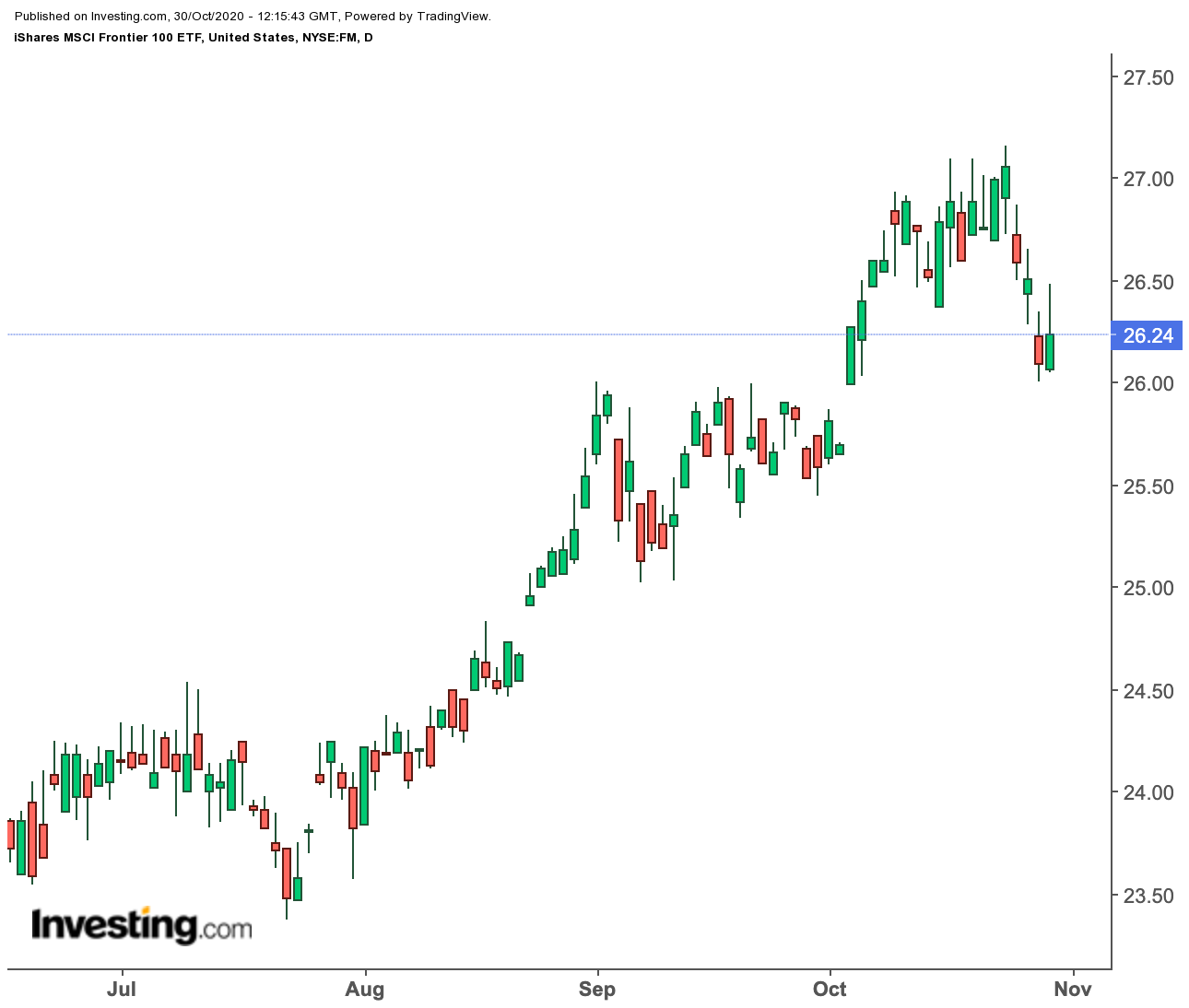While the third quarter ends on a highly volatile note in broader U.S. markets, today we turn our attention to exchange-traded funds (ETFs) in international markets, namely frontier markets and Africa. Compared with many other regions and countries, there is considerably little analyst coverage of these markets. Therefore, investing via an ETF may be more appropriate for most investors.
Most market participants tend to invest in their home countries, at least early in their investing journey. On the other hand, frontier, as well as African markets, could offer significant diversification away from developed countries. Let’s take a look.
1. iShares MSCI Frontier 100 ETF
Current price: $26.24
52-week range: $19.35 - $31.35
Yield: 6.07%
Expense ratio: 0.79%
The iShares MSCI Frontier 100 ETF (NYSE:FM) provides exposure to 100 of the largest frontier market stocks. Kuwait, Vietnam, Morocco, Kenya, Romania, Bahrain, Nigeria and Bangladesh are several countries represented in the fund.
Recent academic research highlights:
"Since frontier markets are at their early stages of growth and capitalization, they can provide convenient investment opportunities. That is why interest in frontier markets is developing remarkably."

FM, which started trading in 2012, tracks the MSCI Frontier Markets 100 Index. The top 10 names make about 40% of net assets, which stand at $380 million.
National Bank Of Kuwait Sak (KW:NBKK), Bahrain-based Ahli United Bank (KW:AUBK), and Kenya-based mobile network operator Safaricom Ltd (NR:SCOM) head the list of businesses. Financials make up about half of the ETF, followed by communication companies (14.96%), consumer staples (7.62) and real estate (5.64%).
So far this year, FM is down about 14%. Trailing P/E and P/B ratios are 10.46 and 1.50, respectively. Contrarian investors looking for value in frontier markets could find the fund's risk/return profile appealing.
2. VanEck Vectors Africa Index ETF
Current price: $17.63
52-week range: $11.24 - 21.98
Yield: 1.92%
Expense ratio: 0.79%
The VanEck Vectors Africa Index ETF (NYSE:AFK) provides exposure to a range of companies focusing on the African continent. Fund sponsors invest in either public companies incorporated in Africa or those that, while incorporated outside of Africa, derive at least half of their revenues from operations on the continent.

According to the African Development Bank Organization (ABDO):
"Africa's economic growth has stabilized at 3.% in 2019, and is expected to pick up to 3.9% in 2020 and 4.1% in 2021, but to remain below historical highs."
ABDO further highlights:
"Growth's fundamentals are also improving, with a gradual shift from private consumption toward investment and exports. For the first time in a decade, investment accounted for more than half the continent's growth, with private consumption accounting for less than one third."
AFK started trading in 2008 and currently has $43 million under management. The ETF, which has 74 holdings, tracks the MVIS® GDP Africa Index.
The top 10 companies comprise close to half of the assets. South Africa-based companies lead the way (32.8%), followed by Morocco (16.96%), Nigeria (11.31%), Kenya (10.51%) and Canada (7.78%).
In terms of sectoral allocation, financials and materials have the highest weighting, each with about 30%, followed by communication services (16.2%), consumer discretionary (11.7) and consumer staples (9.6%).
South Africa-headquartered internet company and e-commerce portal Naspers (OTC:NPSNY), Safaricom Ltd (NR:SCOM) and Morocco-based financial services group Attijariwafa Bank (CS:ATW) lead the list of companies in the fund.
Since the start of the year, the fund is down about 14%. Trailing P/E and P/B ratios stand at 12.14 and 1.54, respectively. We believe the fund deserves to be on the watchlist of investors who are bullish on Africa's long-term growth.
Bottom Line
Broader U indices offer plenty of stocks with growth potential. Yet, there is a whole investing world out there in proverbial terms, waiting to be discovered.
In previous articles, we covered a range of countries and regions, including Italy and Taiwan, Asia-Pacific, China, Australia and Mexico, Canada and Russia, the UK and continental Europe, and emerging markets, including India.
We will look at other countries in the coming weeks.
